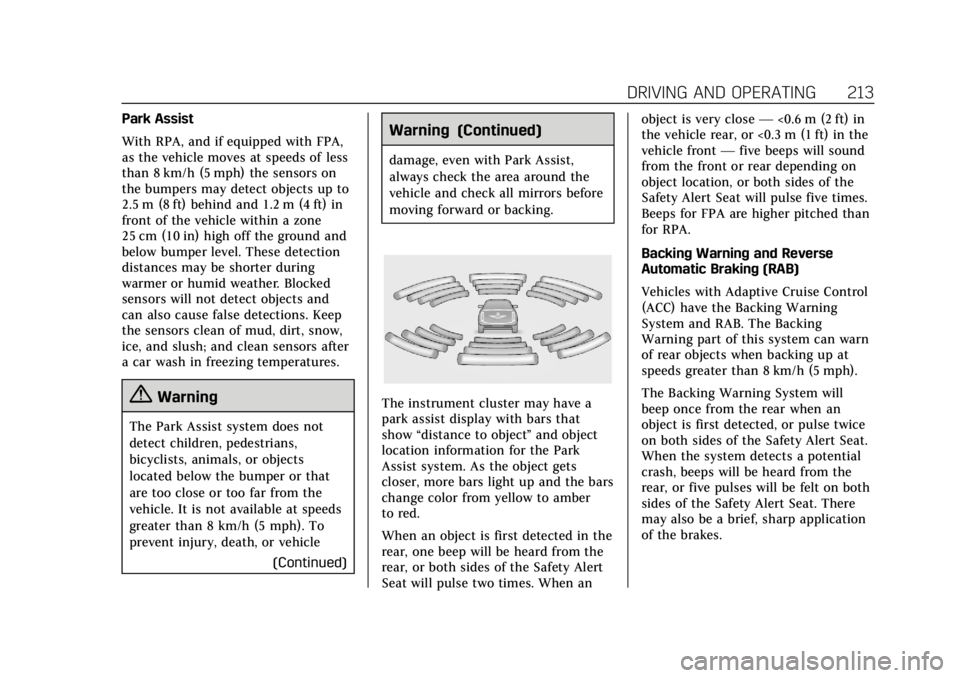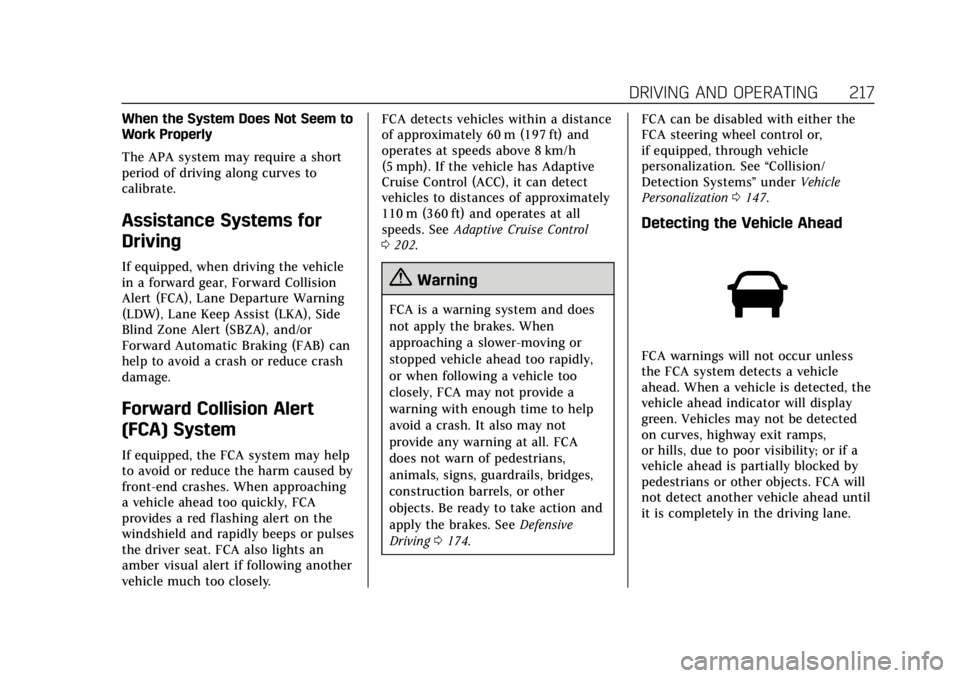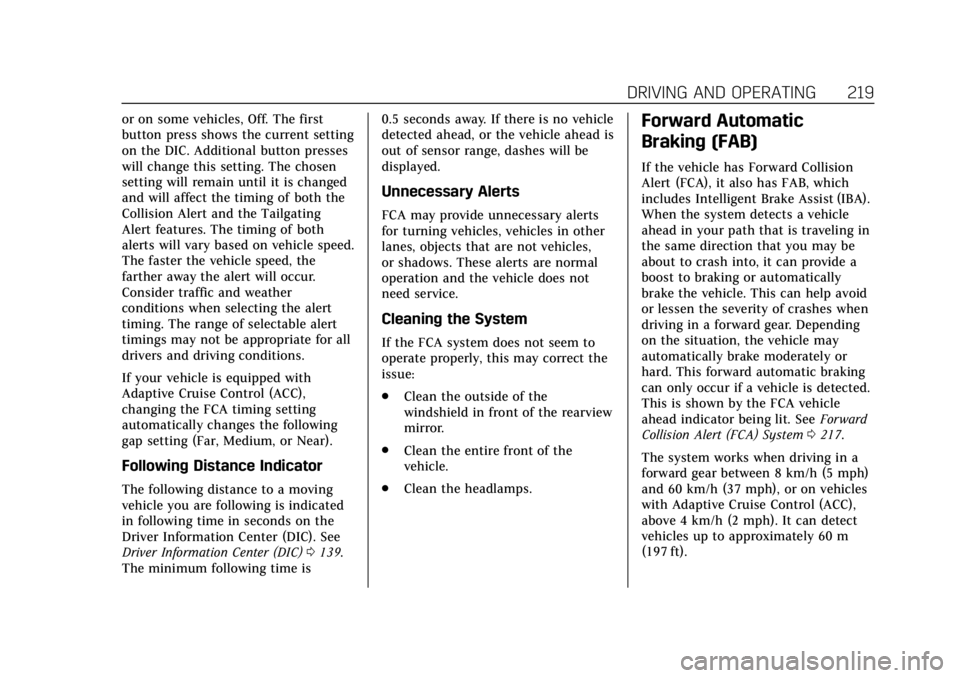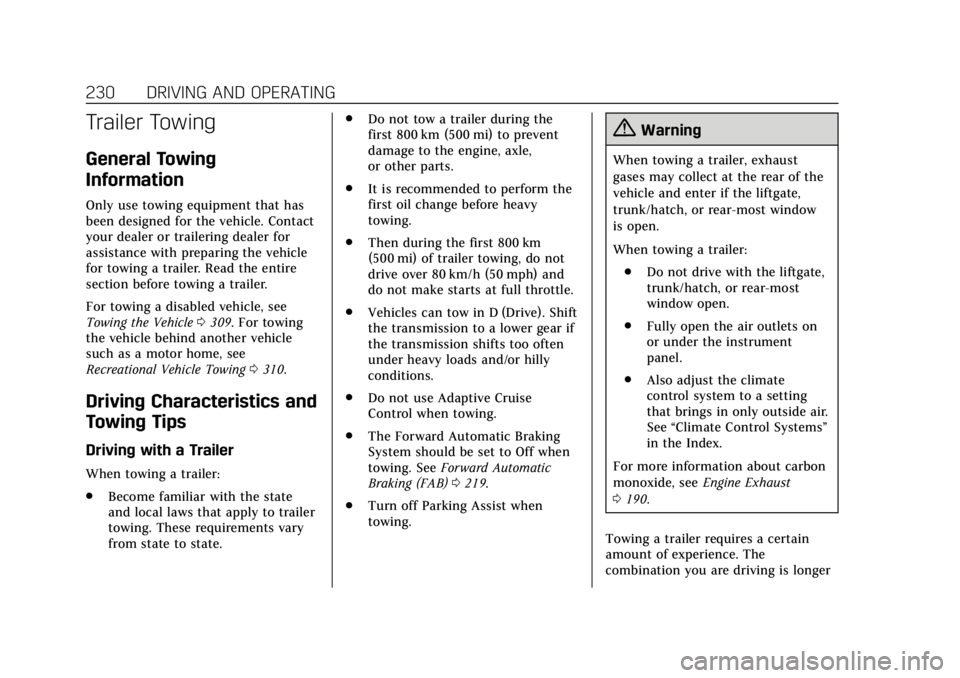Adaptive cruise control CADILLAC ATS 2018 User Guide
[x] Cancel search | Manufacturer: CADILLAC, Model Year: 2018, Model line: ATS, Model: CADILLAC ATS 2018Pages: 376, PDF Size: 6.71 MB
Page 204 of 376

Cadillac XTS Owner Manual (GMNA-Localizing-U.S./Canada-12032610) -
2019 - crc - 8/22/18
DRIVING AND OPERATING 203
J:Press to turn the system on or
off. The indicator turns white on the
instrument cluster when ACC is
turned on.
+RES : Press the control up briefly to
resume the previous set speed or to
increase vehicle speed if ACC is
already engaged. To increase speed by
1 km/h (1 mph), press +RES up to the
first detent. To increase speed to the
next 5 km/h (5 mph) mark on the
speedometer, press +RES up to the
second detent.
SET– :Press the control down briefly
to set the speed and activate ACC or
to decrease vehicle speed if ACC is already engaged. To decrease speed by
1 km/h (1 mph), press SET−
down to
the first detent. To decrease speed to
the next 5 km/h (5 mph) mark on the
speedometer, press SET− down to the
second detent.
*: Press to disengage ACC without
erasing the selected set speed.
[: Press to select a following gap
time (or distance) setting for ACC of
Far, Medium, or Near.
The speedometer reading can be
displayed in either English or metric
units. See Instrument Cluster 0121.
The increment value used depends on
the units displayed.
Switching Between ACC and
Regular Cruise Control
To switch between ACC and regular
cruise control, press and hold
*.
A Driver Information Display (DIC)
message displays. See Vehicle Messages
0 146.
ACC IndicatorRegular Cruise
Control Indicator
When ACC is engaged, a green
o
indicator will be lit on the instrument
cluster. When the regular cruise
control is engaged, a green
J
indicator will be lit on the instrument
cluster.
When the vehicle is turned on, the
cruise control mode will be set to the
last mode used before the vehicle was
turned off.
Setting Adaptive Cruise Control
If
Jis on when not in use, it could
get pressed and go into cruise when
not desired. Keep
Joff when cruise
is not being used.
Select the set speed desired for cruise.
This is the vehicle speed when no
vehicle is detected in its path.
Page 208 of 376

Cadillac XTS Owner Manual (GMNA-Localizing-U.S./Canada-12032610) -
2019 - crc - 8/22/18
DRIVING AND OPERATING 207
Notification to Resume ACC
ACC will maintain a follow gap behind
a detected vehicle and slow your
vehicle to a stop behind that vehicle.
If the stopped vehicle ahead has
driven away and ACC has not
resumed, the vehicle ahead indicator
will flash as a reminder to check
traffic ahead before proceeding. In
addition, the left and right sides of the
Safety Alert Seat will pulse three
times, or three beeps will sound. See
“Alert Type”and “Adaptive Cruise Go
Notifier” in“Collision/Detection
Systems” underVehicle Personalization
0 147.
When the vehicle ahead drives away,
press +RES or the accelerator pedal to
resume cruise control. If stopped for
more than two minutes or if the driver
door is opened and the driver seat belt
is unbuckled, the ACC automatically
applies the Electric Parking Brake
(EPB) to hold the vehicle. The EPB
status light will turn on. See Electric
Parking Brake 0194. To resume ACC
and release the EPB, press the
accelerator pedal. A DIC warning message may display
indicating to shift to P (Park) before
exiting the vehicle. See
Vehicle
Messages 0146.
{Warning
If ACC has stopped the vehicle, and
if ACC is disengaged, turned off,
or canceled, the vehicle will no
longer be held at a stop. The vehicle
can move. When ACC is holding the
vehicle at a stop, always be
prepared to manually apply the
brakes.
{Warning
Leaving the vehicle without placing
it in P (Park) can be dangerous. Do
not leave the vehicle while it is
being held at a stop by ACC. Always
place the vehicle in P (Park) and
turn off the ignition before leaving
the vehicle. ACC Override
If using the accelerator pedal while
ACC is active, the ACC indicator will
turn blue on the instrument cluster.
ACC will resume operation when the
accelerator pedal is not being pressed.
{Warning
The ACC will not automatically
apply the brakes if your foot is
resting on the accelerator pedal.
You could crash into a vehicle
ahead of you.
Curves in the Road
{Warning
On curves, ACC may not detect a
vehicle ahead in your lane. You
could be startled if the vehicle
accelerates up to the set speed,
especially when following a vehicle
exiting or entering exit ramps. You
could lose control of the vehicle or
crash. Do not use ACC while driving (Continued)
Page 214 of 376

Cadillac XTS Owner Manual (GMNA-Localizing-U.S./Canada-12032610) -
2019 - crc - 8/22/18
DRIVING AND OPERATING 213
Park Assist
With RPA, and if equipped with FPA,
as the vehicle moves at speeds of less
than 8 km/h (5 mph) the sensors on
the bumpers may detect objects up to
2.5 m (8 ft) behind and 1.2 m (4 ft) in
front of the vehicle within a zone
25 cm (10 in) high off the ground and
below bumper level. These detection
distances may be shorter during
warmer or humid weather. Blocked
sensors will not detect objects and
can also cause false detections. Keep
the sensors clean of mud, dirt, snow,
ice, and slush; and clean sensors after
a car wash in freezing temperatures.
{Warning
The Park Assist system does not
detect children, pedestrians,
bicyclists, animals, or objects
located below the bumper or that
are too close or too far from the
vehicle. It is not available at speeds
greater than 8 km/h (5 mph). To
prevent injury, death, or vehicle(Continued)
Warning (Continued)
damage, even with Park Assist,
always check the area around the
vehicle and check all mirrors before
moving forward or backing.
The instrument cluster may have a
park assist display with bars that
show“distance to object ”and object
location information for the Park
Assist system. As the object gets
closer, more bars light up and the bars
change color from yellow to amber
to red.
When an object is first detected in the
rear, one beep will be heard from the
rear, or both sides of the Safety Alert
Seat will pulse two times. When an object is very close
—<0.6 m (2 ft) in
the vehicle rear, or <0.3 m (1 ft) in the
vehicle front —five beeps will sound
from the front or rear depending on
object location, or both sides of the
Safety Alert Seat will pulse five times.
Beeps for FPA are higher pitched than
for RPA.
Backing Warning and Reverse
Automatic Braking (RAB)
Vehicles with Adaptive Cruise Control
(ACC) have the Backing Warning
System and RAB. The Backing
Warning part of this system can warn
of rear objects when backing up at
speeds greater than 8 km/h (5 mph).
The Backing Warning System will
beep once from the rear when an
object is first detected, or pulse twice
on both sides of the Safety Alert Seat.
When the system detects a potential
crash, beeps will be heard from the
rear, or five pulses will be felt on both
sides of the Safety Alert Seat. There
may also be a brief, sharp application
of the brakes.
Page 218 of 376

Cadillac XTS Owner Manual (GMNA-Localizing-U.S./Canada-12032610) -
2019 - crc - 8/22/18
DRIVING AND OPERATING 217
When the System Does Not Seem to
Work Properly
The APA system may require a short
period of driving along curves to
calibrate.
Assistance Systems for
Driving
If equipped, when driving the vehicle
in a forward gear, Forward Collision
Alert (FCA), Lane Departure Warning
(LDW), Lane Keep Assist (LKA), Side
Blind Zone Alert (SBZA), and/or
Forward Automatic Braking (FAB) can
help to avoid a crash or reduce crash
damage.
Forward Collision Alert
(FCA) System
If equipped, the FCA system may help
to avoid or reduce the harm caused by
front-end crashes. When approaching
a vehicle ahead too quickly, FCA
provides a red flashing alert on the
windshield and rapidly beeps or pulses
the driver seat. FCA also lights an
amber visual alert if following another
vehicle much too closely.FCA detects vehicles within a distance
of approximately 60 m (197 ft) and
operates at speeds above 8 km/h
(5 mph). If the vehicle has Adaptive
Cruise Control (ACC), it can detect
vehicles to distances of approximately
110 m (360 ft) and operates at all
speeds. See
Adaptive Cruise Control
0 202.
{Warning
FCA is a warning system and does
not apply the brakes. When
approaching a slower-moving or
stopped vehicle ahead too rapidly,
or when following a vehicle too
closely, FCA may not provide a
warning with enough time to help
avoid a crash. It also may not
provide any warning at all. FCA
does not warn of pedestrians,
animals, signs, guardrails, bridges,
construction barrels, or other
objects. Be ready to take action and
apply the brakes. See Defensive
Driving 0174. FCA can be disabled with either the
FCA steering wheel control or,
if equipped, through vehicle
personalization. See
“Collision/
Detection Systems” underVehicle
Personalization 0147.
Detecting the Vehicle Ahead
FCA warnings will not occur unless
the FCA system detects a vehicle
ahead. When a vehicle is detected, the
vehicle ahead indicator will display
green. Vehicles may not be detected
on curves, highway exit ramps,
or hills, due to poor visibility; or if a
vehicle ahead is partially blocked by
pedestrians or other objects. FCA will
not detect another vehicle ahead until
it is completely in the driving lane.
Page 220 of 376

Cadillac XTS Owner Manual (GMNA-Localizing-U.S./Canada-12032610) -
2019 - crc - 8/22/18
DRIVING AND OPERATING 219
or on some vehicles, Off. The first
button press shows the current setting
on the DIC. Additional button presses
will change this setting. The chosen
setting will remain until it is changed
and will affect the timing of both the
Collision Alert and the Tailgating
Alert features. The timing of both
alerts will vary based on vehicle speed.
The faster the vehicle speed, the
farther away the alert will occur.
Consider traffic and weather
conditions when selecting the alert
timing. The range of selectable alert
timings may not be appropriate for all
drivers and driving conditions.
If your vehicle is equipped with
Adaptive Cruise Control (ACC),
changing the FCA timing setting
automatically changes the following
gap setting (Far, Medium, or Near).
Following Distance Indicator
The following distance to a moving
vehicle you are following is indicated
in following time in seconds on the
Driver Information Center (DIC). See
Driver Information Center (DIC)0139.
The minimum following time is 0.5 seconds away. If there is no vehicle
detected ahead, or the vehicle ahead is
out of sensor range, dashes will be
displayed.
Unnecessary Alerts
FCA may provide unnecessary alerts
for turning vehicles, vehicles in other
lanes, objects that are not vehicles,
or shadows. These alerts are normal
operation and the vehicle does not
need service.
Cleaning the System
If the FCA system does not seem to
operate properly, this may correct the
issue:
.
Clean the outside of the
windshield in front of the rearview
mirror.
. Clean the entire front of the
vehicle.
. Clean the headlamps.
Forward Automatic
Braking (FAB)
If the vehicle has Forward Collision
Alert (FCA), it also has FAB, which
includes Intelligent Brake Assist (IBA).
When the system detects a vehicle
ahead in your path that is traveling in
the same direction that you may be
about to crash into, it can provide a
boost to braking or automatically
brake the vehicle. This can help avoid
or lessen the severity of crashes when
driving in a forward gear. Depending
on the situation, the vehicle may
automatically brake moderately or
hard. This forward automatic braking
can only occur if a vehicle is detected.
This is shown by the FCA vehicle
ahead indicator being lit. See Forward
Collision Alert (FCA) System 0217.
The system works when driving in a
forward gear between 8 km/h (5 mph)
and 60 km/h (37 mph), or on vehicles
with Adaptive Cruise Control (ACC),
above 4 km/h (2 mph). It can detect
vehicles up to approximately 60 m
(197 ft).
Page 231 of 376

Cadillac XTS Owner Manual (GMNA-Localizing-U.S./Canada-12032610) -
2019 - crc - 8/22/18
230 DRIVING AND OPERATING
Trailer Towing
General Towing
Information
Only use towing equipment that has
been designed for the vehicle. Contact
your dealer or trailering dealer for
assistance with preparing the vehicle
for towing a trailer. Read the entire
section before towing a trailer.
For towing a disabled vehicle, see
Towing the Vehicle0309. For towing
the vehicle behind another vehicle
such as a motor home, see
Recreational Vehicle Towing 0310.
Driving Characteristics and
Towing Tips
Driving with a Trailer
When towing a trailer:
.
Become familiar with the state
and local laws that apply to trailer
towing. These requirements vary
from state to state. .
Do not tow a trailer during the
first 800 km (500 mi) to prevent
damage to the engine, axle,
or other parts.
. It is recommended to perform the
first oil change before heavy
towing.
. Then during the first 800 km
(500 mi) of trailer towing, do not
drive over 80 km/h (50 mph) and
do not make starts at full throttle.
. Vehicles can tow in D (Drive). Shift
the transmission to a lower gear if
the transmission shifts too often
under heavy loads and/or hilly
conditions.
. Do not use Adaptive Cruise
Control when towing.
. The Forward Automatic Braking
System should be set to Off when
towing. See Forward Automatic
Braking (FAB) 0219.
. Turn off Parking Assist when
towing.
{Warning
When towing a trailer, exhaust
gases may collect at the rear of the
vehicle and enter if the liftgate,
trunk/hatch, or rear-most window
is open.
When towing a trailer:
. Do not drive with the liftgate,
trunk/hatch, or rear-most
window open.
. Fully open the air outlets on
or under the instrument
panel.
. Also adjust the climate
control system to a setting
that brings in only outside air.
See “Climate Control Systems ”
in the Index.
For more information about carbon
monoxide, see Engine Exhaust
0 190.
Towing a trailer requires a certain
amount of experience. The
combination you are driving is longer
Page 365 of 376

Cadillac XTS Owner Manual (GMNA-Localizing-U.S./Canada-12032610) -
2019 - crc - 8/22/18
364 INDEX
IndexA
Accessories and Modifications . . . . . 238
Accessory Power . . . . . . . . . . . . . . . . . . . . 188
Adaptive Cruise Control . . . . . . . . . . . . 202
Add-On Electrical Equipment . . . . . . 235
Additional InformationOnStar . . . . . . . . . . . . . . . . . . . . . . . . . . . . . 354
Additional Maintenance and Care . . . . . . . . . . . . . . . . . . . . . . . . . . . 329
Adjustments
Lumbar, Front Seats . . . . . . . . . . . . . . . . 57
Thigh Support . . . . . . . . . . . . . . . . . . . . . . 59
Air Cleaner/Filter, Engine . . . . . . . . . . 248
Air Conditioning . . . . . . . . . . . . . . .163, 168
Air Filter, Passenger Compartment . . . . . . . . . . . . . . . . . . . . . 170
Air Vents . . . . . . . . . . . . . . . . . . . . . . . . . . . . 169
Airbag System Check . . . . . . . . . . . . . . . . . . . . . . . . . . . . . . . . 88
How Does an Airbag Restrain? . . . . . 81
Passenger Sensing System . . . . . . . . . 82
What Makes an Airbag Inflate? . . . . 80
What Will You See after anAirbag Inflates? . . . . . . . . . . . . . . . . . . . 81
When Should an Airbag Inflate? . . . . . . . . . . . . . . . . . . . . . . . . . . . . . 79
Where Are the Airbags? . . . . . . . . . . . . 78 Airbags
Adding Equipment to the
Vehicle . . . . . . . . . . . . . . . . . . . . . . . . . . . . . 87
Passenger Status Indicator . . . . . . . 130
Readiness Light . . . . . . . . . . . . . . . . . . . 129
Servicing Airbag-Equipped Vehicles . . . . . . . . . . . . . . . . . . . . . . . . . . . . 87
System Check . . . . . . . . . . . . . . . . . . . . . . . 76
Alarm Vehicle Security . . . . . . . . . . . . . . . . . . . . . 41
Alert
Lane Change . . . . . . . . . . . . . . . . . . . . . . 221
Side Blind Zone (SBZA) . . . . . . . . . . 221
All-Season Tires . . . . . . . . . . . . . . . . . . . . . 273
All-Wheel Drive . . . . . . . . . . . . . . . .193, 259
Antilock Brake System (ABS) . . . . . . 194 Warning Light . . . . . . . . . . . . . . . . . . . . 134
Appearance Care Exterior . . . . . . . . . . . . . . . . . . . . . . . . . . . . 312
Interior . . . . . . . . . . . . . . . . . . . . . . . . . . . . 316
Armrest
Rear Seat . . . . . . . . . . . . . . . . . . . . . . . . . . . . 67
Armrest Storage . . . . . . . . . . . . . . . . . . . . . 109
Assistance Systems for Driving . . . . 217
Assistance Systems for Parking and Backing . . . . . . . . . . . . . . . . . . . . . . . 211
Automatic Dimming Mirrors . . . . . . . . . . . . . . . . . . . 45
Page 367 of 376

Cadillac XTS Owner Manual (GMNA-Localizing-U.S./Canada-12032610) -
2019 - crc - 8/22/18
366 INDEX
CompartmentsStorage . . . . . . . . . . . . . . . . . . . . . . . . . . . . 108
Compass . . . . . . . . . . . . . . . . . . . . . . . . . . . . . 115
Compressor Kit, Tire Sealant . . . . . . . 293
Connected Services Connections . . . . . . . . . . . . . . . . . . . . . . . 361
Diagnostics . . . . . . . . . . . . . . . . . . . . . . . . 363
Navigation . . . . . . . . . . . . . . . . . . . . . . . . . 360
Connections Connected Services . . . . . . . . . . . . . . . 361
Control
Traction and ElectronicStability . . . . . . . . . . . . . . . . . . . . . . . . . . 196
Control of a Vehicle . . . . . . . . . . . . . . . . 174
Convenience Net . . . . . . . . . . . . . . . . . . . . 111
Convex Mirrors . . . . . . . . . . . . . . . . . . . . . . 44
Coolant Engine Temperature Gauge . . . . . . 128
Engine Temperature WarningLight . . . . . . . . . . . . . . . . . . . . . . . . . . . . . 136
Cooling . . . . . . . . . . . . . . . . . . . . . . . . .163, 168
Cooling System . . . . . . . . . . . . . . . . . . . . . 250
Cornering Lamps . . . . . . . . . . . . . . . . . . . 159
Courtesy Lamps . . . . . . . . . . . . . . . . . . . . . 159
Courtesy Transportation
Program . . . . . . . . . . . . . . . . . . . . . . . . . . . . 345
Cover Engine . . . . . . . . . . . . . . . . . . . . . . . . . . . . . 243 Cruise Control . . . . . . . . . . . . . . . . . . . . . . . 199
Light . . . . . . . . . . . . . . . . . . . . . . . . . . . . . . . 139
Cruise Control, Adaptive . . . . . . . . . . . 202
Customer Assistance . . . . . . . . . . . . . . . 341 Offices . . . . . . . . . . . . . . . . . . . . . . . . . . . . . 341
Text Telephone (TTY) Users . . . . . 341
Customer Information
Publications OrderingInformation . . . . . . . . . . . . . . . . . . . . . . 348
Customer Satisfaction Procedure . . . . . . . . . . . . . . . . . . . . . . . . . . 339
D
Damage Repair, Collision . . . . . . . . . . . 346
Danger, Warning, and Caution . . . . . . . . 2
Data CollectionInfotainment System . . . . . . . . . . . . . 351
OnStar . . . . . . . . . . . . . . . . . . . . . . . . . . . . . 351
Data Recorders, Event . . . . . . . . . . . . . . 350
Daytime Running Lamps (DRL) . . . 157
Defensive Driving . . . . . . . . . . . . . . . . . . . 174
Delayed Locking . . . . . . . . . . . . . . . . . . . . . 37
Diagnostics Connected Services . . . . . . . . . . . . . . . 363
Distracted Driving . . . . . . . . . . . . . . . . . . 173
Dome Lamps . . . . . . . . . . . . . . . . . . . . . . . . 159
Door Ajar Light . . . . . . . . . . . . . . . . . . . . . . . . . 139 Door (cont'd)
Delayed Locking . . . . . . . . . . . . . . . . . . . . 37
Locks . . . . . . . . . . . . . . . . . . . . . . . . . . . . . . . . 35
Power Locks . . . . . . . . . . . . . . . . . . . . . . . . . 37
Rear Seat Pass-Through . . . . . . . . . . . . 68
Drive Belt Routing, Engine . . . . . . . . . 338
Drive Systems All-Wheel Drive . . . . . . . . . . . . . . 193, 259
Driver Assistance Systems . . . . . . . . . 209
Driver Information
Center (DIC) . . . . . . . . . . . . . . . . . . . . . . . 139
Driving Assistance Systems . . . . . . . . . . . . . . . 217
Characteristics andTowing Tips . . . . . . . . . . . . . . . . . . . . . 230
Defensive . . . . . . . . . . . . . . . . . . . . . . . . . . 174
Drunk . . . . . . . . . . . . . . . . . . . . . . . . . . . . . . 174
For Better Fuel Economy . . . . . . . . . . . 25
Hill and Mountain Roads . . . . . . . . 177
If the Vehicle is Stuck . . . . . . . . . . . . 179
Loss of Control . . . . . . . . . . . . . . . . . . . . 176
Off-Road Recovery . . . . . . . . . . . . . . . . 176
Vehicle Load Limits . . . . . . . . . . . . . . 179
Wet Roads . . . . . . . . . . . . . . . . . . . . . . . . . 176
Winter . . . . . . . . . . . . . . . . . . . . . . . . . . . . . 178
Dual Automatic Climate Control System . . . . . . . . . . . . . . . . . . . . 163